My first visit to Mt Yokoyama entailed a tricky ridge scramble on rotting snow. Despite the difficulty with the snow conditions, the virgin beech forests clinging tightly to the mountain contours left an impression on me, and I vowed to return during the foliage season. Fast forward a few years to early November, and when pressed for a recommendation for an autumn hike, I immediately suggested to Hisao that he give Yokoyama a chance. Tucked in a forgotten corner of northeastern Shiga Prefecture, it would take an early start and a bit of planning to make it all work. Hisao happened to be in town for the Banff Mountain Film Festival, creating the ultimate opportunity to see our plan bear fruition. After a day of inspiring movies, Hisao and I head back to my home for an early night and long day ahead. We set the alarm for 4:30am, but I am awake by 4, excited by the promise of a beautiful day.

We hit the road by 5 for the two-hour drive and roll into the parking lot right at 7am. The last several kilometers along the rural road from Kinomoto see our target peak basking in the dawn light—even from here the climb looks impossibly steep as the massif literally towers over the sleepy hamlet. After using the barebones toilet facility, Hisao and I study the map and wait for 10 minutes until Yasu and Kaori pull into the narrow trailhead parking lot. Excitement resonates through the air as the crystal clear skies greet us like an old friend. Our route this time is the famed Shiratani Honryū, a scramble up a steep mountain stream: a direttissima earning the respect of all those who commit to the steep contours flanking the southern face of Yokoyama. During our first visit, the village caretaker rushed up to the trailhead in his utility truck to warn us off the route in winter but now it is time to give the route its due shine.

A rugged forest road doubles as our access route for the first few minutes before abruptly terminating at the water’s edge for the first of a series of river crossings. Skyward we gaze at the blazing foliage coating the spurs on both sides of our narrow channel. Greenery still clings tightly to the hillsides as if to ward off the encroaching winter. I take the lead, following the faint track higher up the constricted valley. At the top of a gentle rise I gaze ahead and spy a trio of hikers making their way up a series of jagged switchbacks that terminate at a forest road cutting sideways a quarter of the way up the mountain. Despite the human development on the lower flanks of the mountain, the forests have somehow been spared the wrath of the desecrators who have destroyed Japan’s natural forests by smothering them in cedar and cypress.

After an abrupt drop flanked by fixed ropes to the river and a short scramble through a side tributary, we reach those switchbacks and make our way up to the forest road, the final few steps made easier via a steel ladder flanking the two-meter-high concrete retaining wall. Here we turn left on the gravel road for 100 meters before leaving the human development for good by returning to Shiratani on a path splitting off the right shoulder of the lane. Yet more river crossings await as the three of us commence on a somewhat steep ascent past the multi-tiered Kyō-no-taki (経ノ滝) falls. We pause briefly to delayer and admire the ribbon-like cascade.

Left the path goes, straight up a rope-smothered slope in fact, to meet the start of a narrow spur still sitting in the cool shade as the sun has yet to lick these secluded corners of the gorge. We force ourselves up the near-vertical embankment and onto the relative safety of the spur that leads above the falls and onto yet another series of river crossings. The track soon reaches a clearing, affording tantalizing vistas back toward our route and further onward to Kinomoto and the shores of Lake Biwa. To say that the scenery resembles a landscape painting would be an understatement, as we could literally have gazed for hours, entranced in the utter beauty spread out before us.
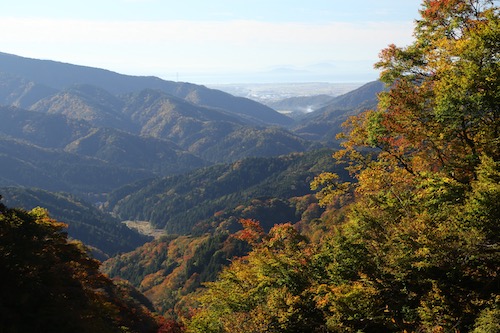
Higher and higher we rise to meet the slivers of sun working their way down the slopes. The warmth that it brings is most welcome as we have spent the entire morning in the chilly shadows of the gorge, and up through a latticework of fixed ropes we ascend, reaching the base of the multi-tiered Gochōshi Falls. Hisao erupts in delight, as his hometown of Choshi (銚子) city in Chiba Prefecture shares the same kanji characters as this waterfall. We take our first break of the morning here, wiping the sweat off our brows while taking in the vistas back to the valley behind us. We share a few snacks and bask in the warm rays of sunlight. It is just past 9am and most other the other hikers are probably just beginning to set foot on the trail.

From here it is a straight shot up to the summit, but first we need to navigate up and over the falls. Fortunately a track to our left grants us passage along a narrow, somewhat dizzying rope-lined traverse tinged with autumnal hues. You really have to focus on the terrain here and not get spellbound by the splendid scenery and lose your footing.

Above the falls the track veers left once again onto the crux of the route, as the angle intensifies. Fortunately for us, we have reached a different kind of intensity as we reach the peak of the fiery autumnal tones. I scream with delight at literally every step upward as a chorus of oohs and aahs follows.

Our pace grinds to a crawl and for good reason, for never in the Kansai region have I bore witness to such fierce colors set against only the most cobalt of skies.

At the base of a trio of horse chestnut trees towering toward the sky, I find a peculiar heart-shaped rock clinging to the steep hillside. Has it been placed here by a pair of star-crossed lovers, or just a lucky find among the scattered fragments of rocks interspersed among the freshly fallen leaves? Regardless, the golden hues of the broad-leaf chestnut provide a most fitting backdrop.

While the lightshow above is nothing short of stunning, a glance over to the neighboring spur sends us into an excited frenzy of shrills and adolescent screams.

I snap a photo at literally every step upwards, trying to capture just a tiny bit of the spectacle for others not lucky enough to witness nature’s perfection. Imagine how beautiful Japan must have been when every forest took on these deciduous tones every autumn. It is hard to find a mountain in Kansai that hasn’t had its slopes desecrated by the cedar planters, so when a completely untamed mountain presents itself for show, you had better pay it some respect.

Those words come to me in a semi-concussed state, for after navigating through a narrow gap in a rock formation above, I stand prematurely and smash my noggin up against a toppled beech tree, which has me seeing stars as I lurch forward to regain my composure. Luckily the smooth bark fails to create a puncture wound, so I can continue forward in a careful yet bloodless state.

Using this collision as an opportunity to slow up the pace, I gaze up toward my canopy of blazing reds and vivid yellows as we continue our steady pace along the ever-steepening spur. The contours on the map are so close together it’s a wonder there is any room for a path at all, and every 50 meters or so we clamber through some rock formations that have somehow managed to defy gravity as they cling to the rugged hillside.
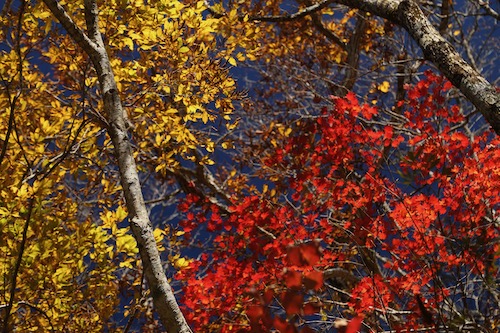
Beech tree leaves do not retain their color for long periods of time, with the transformation from brilliant yellow to muted brown occurring over the course of just a few days, so we consider ourselves lucky with such perfect timing as to witness the brilliance of this autumnal performance.

The spur continues to steepen as we make our way through a network of bowed trees, crags and fixed ropes, punctuated at irregular intervals by rotting signposts clinging awkwardly to the gnarled slopes in a gravity-defying manner. Pink tape marks guide us upwards along the narrow spur, coaxing us along like signal beacons lining a crowded cove, but for us the harbor is crammed with towering beech, oak and maple. Finally, after the better part of an hour, the angle subsides and ushers us up onto the broad ridge of Yokoyama.

We pop out on the treeless summit at preciously 10:30am. A pair of hikers laze in the warm sun but apart from this duo, we find ourselves completely alone. One lonesome raggedy old prefab structure sits on the northern edge of the high point, looking even more lopsided that during my first visit to the mountain. Ignoring common sense, I scale the rickety metal ladder tied onto the side of the shack and scramble onto the roof looking for a glimpse of Hakusan to the north. Alas, the sacred peak is shielded from view by a series of smaller mountain ridges ablaze in autumn hues.

Lazing in the warm sunshine seems like the best course of action, and between mid-morning snacks our companion Kaori settles in for a power map while Hisao, Yasu and I gaze down at the shores of Lake Yogo, a tiny dot of a tarn as it appears from these hallowed heights. Yogo itself sits at the northernmost tip of Lake Biwa, separated by the sprawling ridgeline of the Sengoku-signficiant Shizugatake. The better part of 30 minutes is spent in such perfect reverie among the soothing air of autumn.

Eventually the four of us garner up the strength and courage to embark on the long-awaited walk along the spine of the range to neighboring eastern peak of Yokoyama. Although the main peak of Yokoyama is devoid of clear views, a short walk east takes visitors onto a narrow sliver of track affording vistas that can only be described as life-altering, for once slip down the rugged cliff face will do just that.

As we push on closer to the eastern summit, a solo hiker approaches on his way west toward the main peak, and as he passes, he offers us just the bit of news we were hoping to receive: the Alps are visible. This titillating snippet is all that it takes to send us in a frantic scramble to the east peak, where we do indeed find those ever elusive views north.

We can count no fewer than 10 Hyakumeizan on the horizon, in an expanse spreading west from Mt Arashima all the way across the horizon to Mt Ibuki on our eastern field of view. Between, Mt Ena looks on with envy as the faintly visible Chuo Alps run behind the imposing volcanic edifice of Ontake. Mt Norikura, Hotaka and Kasa also make an appearance along with the bald cap of Hakusan poking its snow-free head above a bank of white cloud.
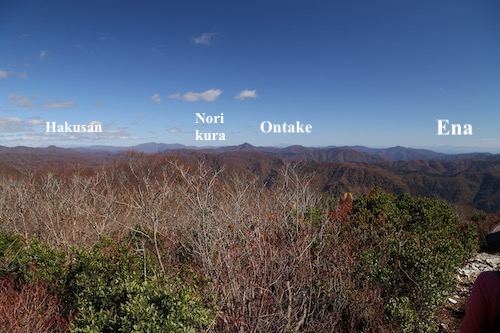
With a tinge of reluctance, we bid farewell to the glorious views and duck back into the bare virgin beech forests, which slowly come to life as we once again descend below 1000 meters and into the peak of the autumn blaze. The colors come gradually: at first a lonesome maple against a backdrop of gray beech but slowly the colorful canopy begins to overtake us.
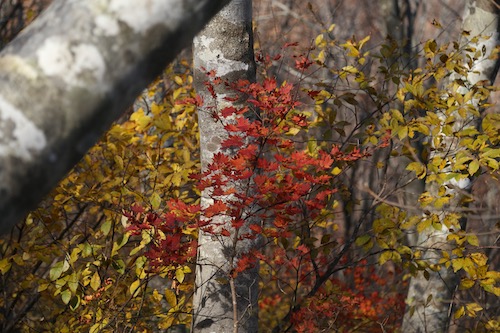
And overtake it does, grasping us in a viselike grip as if to say “you will walk slowly and give us our due respect.” And we give into the temptation and do indeed slow our pace to a crawl, smiles spreading across our contented faces as we search for the right words to express our appreciation.

21 years of hiking in the Kansai region and never have I encountered such perfect hues of autumn color.
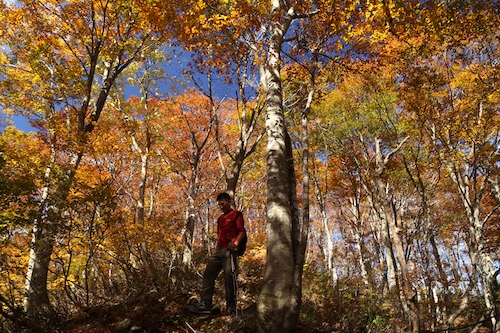
As with all good things, they must surely come to an end, as we pass into the lower depths of the forest and right into a small sliver of planted cedar hugging the edge of a dirt forest road. It looks as if the tree planters started their clear-cutting but stopped short of a full-on invasion, perhaps with a tinge of guilt at attempting to destroy one of the best forests in western Japan. Or perhaps the hallowed beech groves of Yokoyama are on borrowed time. Regardless, I grasp tightly onto the fixed ropes guiding me down an incredibly steep track to the forest road, which eventually leads back to our vehicle.

We top off our trip by a short visit to an obscure old ore mine that Studio Ghibli fans have taken to call a real-life version of Laputa, a perfect ending to our flawless autumn trip to Yokoyama.
